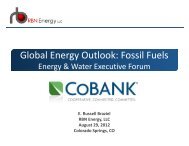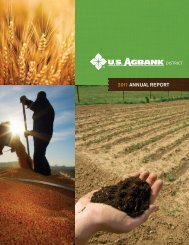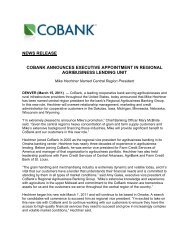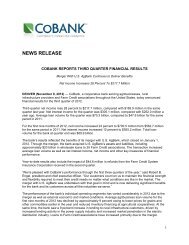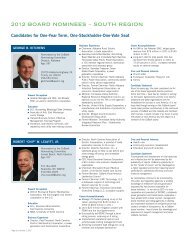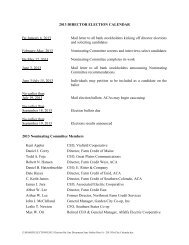All patronage payments and retirements of equity requirethe prior approval of our Board of Directors, which hasincreased or decreased such payments based upon the Bank’scurrent or projected business performance and capital levels.In addition, patronage payments can only be made if the Bankis in compliance with minimum regulatory capitalrequirements.Patronage distributions are made in the form of cash andcommon stock, as shown in the following table. Eligibleshareholders will receive patronage distributions from <strong>CoBank</strong>for 2011 in the first quarter of 2012. Patronage distributionsfor 2011 were higher than the prior year primarily due to anincrease in the level of patronage-based agribusiness averageloan volume.Patronage Distributions ($ in Thousands)Year Ended December 31, 201120102009Common Stock $ 109,900 $ 90,450 $ 85,067Cash 230,751 194,110 183,828Total Patronage Distributions $ 340,651 $ 284,560 $ 268,895Patronage Distributions/Total Average Common StockOwned by Active Borrowers 22.65 % 19.77 % 19.68 %Economic CapitalEconomic capital is a measure of risk and is defined asthe amount of capital required to absorb potential lossesresulting from extremely severe events over a one-year timeperiod. “Unexpected losses” are the difference betweenpotential extremely severe losses and the expected (average)loss over a one-year time period. The amount of economiccapital required is based on our risk profile and a targetedsolvency standard. We attribute economic capital to creditrisk, interest rate risk, operational risk and market risk. Creditrisk, interest rate risk and operational risk are described under“Corporate Risk Profile” beginning on page 43. Market riskrepresents exposure to asset residual values related to ourleasing activity. These risks are measured and aggregated toestimate the exposure to potential extremely severe events andany impact to our capital.The economic capital model considers the economiccapital requirements of our affiliated Associations through theevaluation of the Associations’ retail credit risk, operationalrisk and interest rate risk. An economic capital shortfall(which is the difference between available capital and requiredeconomic capital) at any affiliated Association is included inour economic capital requirements.For economic capital modeling purposes, we havetargeted a “AA” solvency standard, which equates to a99.97 percent confidence level. In other words, the likelihoodof incurring losses greater than the required economic capitalamount is estimated to be similar to the likelihood of a AAratedbond defaulting, which is a 0.03 percent probability. AtDecember 31, 2011, the Bank held capital in excess of theamount calculated by its economic capital model.Credit Risk CapitalCredit risk capital requirements are based on the riskprofile of the borrower or counterparty, repayment sources,the nature of underlying collateral and other support, givencurrent events and conditions. Our credit risk ratings processuses a two dimensional loan rating structure, incorporating our14-point risk-rating scale to identify and track the probabilityof borrower default and a separate scale addressing loss givendefault.In assigning credit risk capital, our economic capitalmodel considers retail borrower probability of default, lossgiven default, and portfolio concentrations. Other principaldrivers of credit risk that differentiate capital allocationinclude exposure at default, asset maturity, and asset and intercommoditycorrelations. We have developed standards forprobability of borrower default and loss given default, basedon external benchmarks.Interest Rate Risk CapitalThe amount of capital attributed to interest rate risk isbased on potential changes in our market value of equity,calculated under randomly generated interest rate scenarios.We utilize widely accepted, third-party models to quantify theinterest rate risk and related risk capital requirement.Operational Risk CapitalOur approach to quantifying operational risk capital isbased on the capital of non-financial companies with similarbusiness risks. These non-financial companies hold capitalprimarily for operational risk. Their level of capital and creditrating yields an inferred estimate of the level of capital to beheld for operational risk. Capital as a percent of operatingexpenses is the primary methodology used in determiningoperational risk capital.Market Risk CapitalMarket risk arises primarily from the volatility in theresidual value of leased assets at the maturity of leasecontracts. This risk exists because of the mismatch betweenthe present value of future cash flows, the present value of thereturned leased asset, and the underlying value of theequipment over time. This is because default can occur whenthe inherent value of the leased asset is below that of thepresent value of all future payments. This difference is used tocalculate the exposure.Other RisksOther areas of risk in which we may have exposure arestructural, liquidity, regulatory, reputation, and political risk.While capital is not specifically attributed to these risks, someof the excess capital – the amount by which book capitalexceeds economic capital – is held for these other risks.<strong>CoBank</strong> 2011 <strong>Annual</strong> <strong>Report</strong>59
Critical Accounting EstimatesManagement’s discussion and analysis of the financialcondition and results of operations are based on the Bank’sconsolidated financial statements, which we prepare inaccordance with accounting principles generally accepted inthe United States of America. In preparing these financialstatements, we make estimates and assumptions. Our financialposition and results of operations are affected by theseestimates and assumptions, which are integral tounderstanding reported results.Note 2 to the accompanying consolidated financialstatements contains a summary of our significant accountingpolicies. We consider certain of these policies to be critical tothe presentation of our financial condition, as they require usto make complex or subjective judgments that affect the valueof certain assets and liabilities. Some of these estimates relateto matters that are inherently uncertain. Most accountingpolicies are not, however, considered critical. Our criticalaccounting policies relate to determining the level of ourreserve for credit exposure and the valuation of financialinstruments with no ready markets (primarily derivatives andcertain investment securities). Management has reviewedthese critical accounting policies with the Audit Committee ofthe Board of Directors.Certain of the statements below contain forward-lookingstatements, which are more fully discussed on page 63.Reserve for Credit ExposureOur allowance for loan losses reflects an adjustment tothe value of our total loan and finance lease portfolio forinherent credit losses related to outstanding balances. Weprovide line of credit financing to customers to cover shorttermand variable needs, the usage of which, particularly forfarm supply and grain marketing customers, is influenced byvolatility in agricultural commodity prices. As a result, wehave significant unfunded commitments for which wemaintain a separate reserve. This reserve is reported as aliability on the Bank’s consolidated balance sheet. We refer tothe combined amounts of the allowance for loan losses and thereserve for unfunded commitments as the “reserve for creditexposure.”Our reserve for credit exposure reflects our assessment ofthe risk of probable and estimable loss related to outstandingbalances and unfunded commitments in our loan and financelease portfolio. The reserve for credit exposure is maintainedat a level consistent with this assessment, considering suchfactors as loss experience, portfolio quality, portfolioconcentrations, current production conditions, and economicand environmental factors specific to our business segments.The reserve for credit exposure is based on our regularevaluation of our loan and finance lease portfolio. Weestablish the reserve for credit exposure via a process thatbegins with estimates of probable loss within the portfolio.Our methodology consists of analysis of specific individualcredits and evaluation of the remaining portfolio. We evaluatesignificant individual credit exposures, including adverselyclassified loans, based upon the borrower’s overall financialcondition, resources, payment record and projected viability.We also evaluate the prospects for support from anyfinancially viable guarantors and the estimated net realizablevalue of any collateral. Senior-level committees approvespecific credit and reserve-related activities. The Audit andRisk Committees of the Board of Directors review andapprove the reserve for credit exposure prior to final approvalby the Board of Directors.Our determination of the reserve for credit exposure issensitive to the assigned risk ratings and probabilities ofdefault, as well as assumptions surrounding loss given default.Changes in these components underlying this criticalaccounting estimate could increase or decrease our provisionfor loan losses. Such a change would increase or decrease netincome and the related allowance for loan losses and reservefor unfunded commitments, which could have a material effecton the Bank’s financial position and results of operations.To analyze the impact of assumptions on our provisionexpense and the related reserve for credit exposure, wechanged a critical assumption to reflect the impact ofdeterioration or improvement in loan quality. In the event that10 percent of loans (calculated on a pro-rata basis across allrisk ratings), excluding loans to Associations and guaranteedloans, experienced downgrades or upgrades of one risk ratingcategory, the provision for loan losses and related reserve forcredit exposure would have increased or decreased by$7.9 million at December 31, 2011.Valuation of Financial Instruments with No ReadyMarketsWe use fair value measurements to record fair valueadjustments to certain financial instruments and to determinefair value disclosures. All of our investment securities andderivative instruments are reported at their estimated fair valueon the accompanying consolidated balance sheets.As discussed in Note 12 to the accompanyingconsolidated financial statements, we maximize the use ofobservable inputs when measuring fair value. Observableinputs reflect market-derived or market-based informationobtained from independent sources, while unobservable inputsprimarily reflect our estimates about market data.The fair value of our investment securities is determinedby a third-party pricing service that uses valuation models toestimate current market prices. Inputs and assumptions relatedto these models are typically observable in the marketplace.Such models incorporate prepayment assumptions andunderlying mortgage- or asset-backed collateral information togenerate cash flows that are discounted using appropriatebenchmark interest rate curves and volatilities. These thirdpartyvaluation models also incorporate information regardingbroker/dealer quotes, available trade information, historicalcash flows, credit ratings, and other market information. Suchvaluations represent an estimated exit price, or price to bereceived by a seller in active markets to sell the investmentsecurities to a willing participant.<strong>CoBank</strong> 2011 <strong>Annual</strong> <strong>Report</strong>60
- Page 4 and 5:
Everett DobrinskiChairmanRobert B.
- Page 6 and 7:
“ We firmly believe the combined
- Page 8 and 9:
associations are partnering with Co
- Page 11 and 12:
2012 BOARD OF DIRECTORSOccupation:F
- Page 13 and 14: “WE ARE COMMITTEDTO GOOD GOVERNAN
- Page 15 and 16: U.S. AgBank CEO Darryl Rhodes (fron
- Page 17 and 18: KansasNew MexicoUtahFC of Ness City
- Page 19 and 20: CorporateCitizenshipAT COBANKSuppor
- Page 21 and 22: StrategicRelationshipsFarm Credit o
- Page 23 and 24: RegionalAgribusinessBANKING GROUPCe
- Page 25 and 26: CorporateAgribusinessBANKING GROUPK
- Page 27 and 28: ElectricDistributionBANKING DIVISIO
- Page 29 and 30: Power SupplyBANKING DIVISIONTri-Sta
- Page 31 and 32: IndustryPortfoliosCoBank ended 2011
- Page 33 and 34: CoBank is a financially strong,depe
- Page 35 and 36: 30COBANK 2011ANNUAL REPORTbuilding
- Page 37 and 38: The information and disclosures con
- Page 39 and 40: Financial Condition andResults of O
- Page 41 and 42: Provision for Loan Losses and Reser
- Page 43 and 44: Purchased services expense decrease
- Page 45 and 46: AgribusinessOverviewThe Agribusines
- Page 47 and 48: Rural InfrastructureOverviewThe Rur
- Page 49 and 50: Credit ApprovalThe most critical el
- Page 51 and 52: Total nonaccrual loans were $134.9
- Page 53 and 54: Basis RiskBasis risk arises due to
- Page 55 and 56: Our net interest income is lower in
- Page 57 and 58: The notional amount of our derivati
- Page 59 and 60: Reputation Risk ManagementReputatio
- Page 61 and 62: Investment Securities ($ in Million
- Page 63: In accordance with the Farm Credit
- Page 67 and 68: Business OutlookWe closed our merge
- Page 69 and 70: Consolidated Income StatementsCoBan
- Page 71 and 72: Consolidated Statements of Cash Flo
- Page 73 and 74: Consolidated Statements of Changes
- Page 75 and 76: LoansWe report loans, excluding lea
- Page 77 and 78: If we determine that a derivative n
- Page 79 and 80: Reserve for Credit ExposureThe foll
- Page 81 and 82: The information in the tables under
- Page 83 and 84: The following tables present inform
- Page 85 and 86: At December 31, 2011, gross minimum
- Page 87 and 88: For impaired investment securities,
- Page 89 and 90: At December 31, 2011, the assets of
- Page 91 and 92: Preferred StockThe following table
- Page 93 and 94: The following table provides a summ
- Page 95 and 96: AssumptionsWe measure plan obligati
- Page 97 and 98: Incentive Compensation PlansWe have
- Page 99 and 100: Note 11 - Derivative FinancialInstr
- Page 101 and 102: A summary of the impact of derivati
- Page 103 and 104: Due to the uncertainty of expected
- Page 105 and 106: Assets and Liabilities Measured atF
- Page 107 and 108: Note 14 - Segment Financial Informa
- Page 109 and 110: Note 15 - Commitments and Contingen
- Page 111 and 112: Note 18 - Subsequent Events (Unaudi
- Page 113 and 114: Supplemental District Financial Inf
- Page 115 and 116:
Supplemental District Financial Inf
- Page 117 and 118:
Report of Independent AuditorsCoBan
- Page 119 and 120:
Management’s Report on Internal C
- Page 121 and 122:
Annual Report to Shareholders Discl
- Page 123 and 124:
Board of Directors Disclosure as of
- Page 125 and 126:
Board of Directors Disclosure as of
- Page 127 and 128:
Board of Directors Disclosure as of
- Page 129 and 130:
Board of Directors Disclosure as of
- Page 131 and 132:
Senior OfficersCoBank, ACBRobert B.
- Page 133 and 134:
Senior Officers Compensation Discus
- Page 135 and 136:
Senior Officers Compensation Discus
- Page 137 and 138:
Senior Officers Compensation Discus
- Page 139 and 140:
Senior Officers Compensation Discus
- Page 141 and 142:
Senior Officers Compensation Discus
- Page 143 and 144:
Senior Officers Compensation Discus
- Page 145 and 146:
Code of EthicsCoBank, ACBCoBank set
- Page 147 and 148:
CERTIFICATIONI, Robert B. Engel, Pr
- Page 149 and 150:
LeadershipCoBank, ACBRobert B. Enge
- Page 151 and 152:
OfficeLocationsCoBank National Offi



